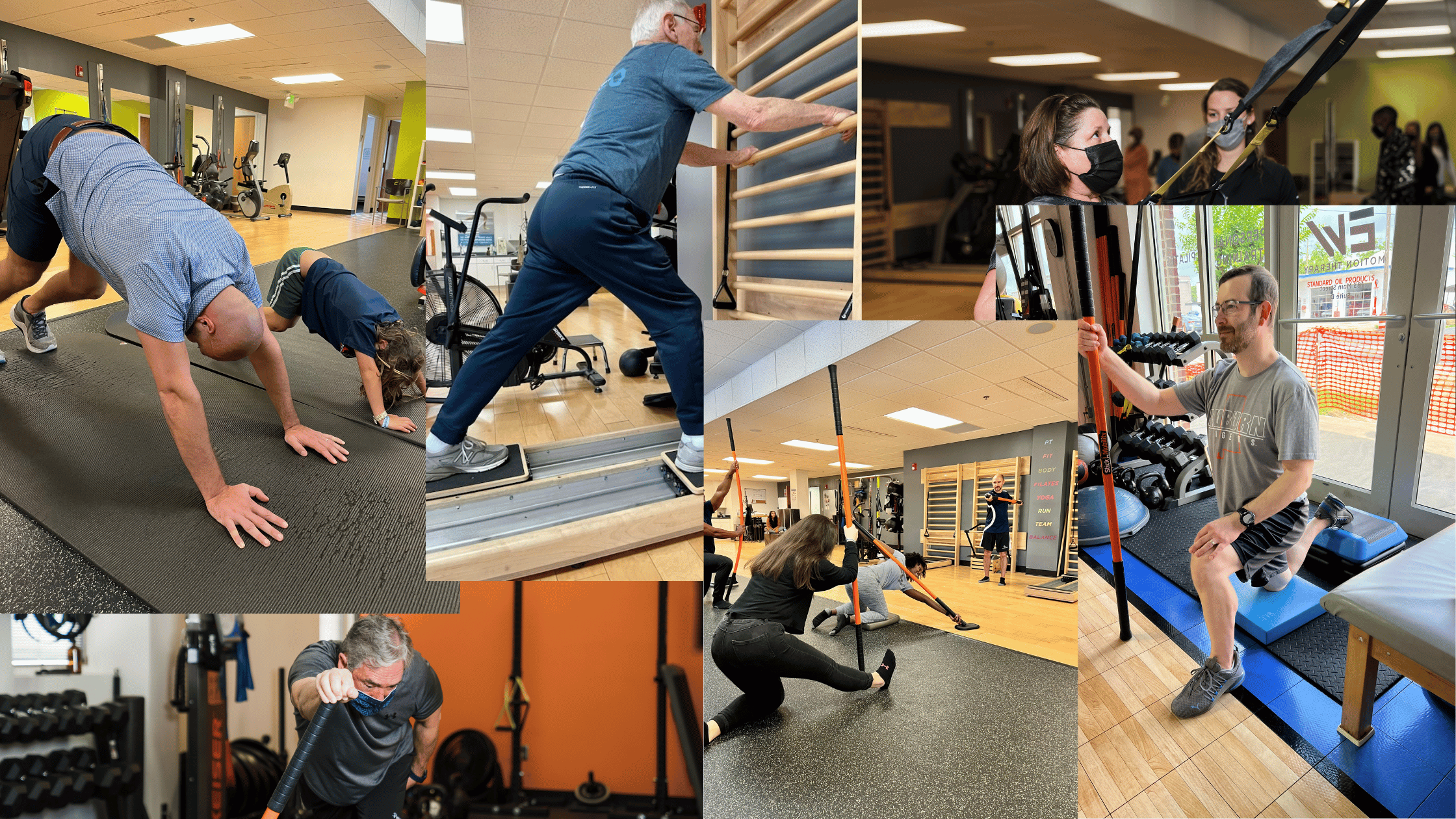EW Personal Training: Our Philosophy

Content Manager // EW Motion Therapy
What do you picture when you think about personal training? Is it a buff young man lifting 20-pound dumbbells while yelling at you to keep going as you run on a treadmill? That’s what pops into my head, and I know I’m not alone. Unfortunately, the reputation of personal training has been tarnished for some because of stereotypical characters like the one I picture, or from a horror story of being injured in the gym. You probably know one, whether you experienced it yourself or someone you know got hurt - a trainer wasn’t paying attention and pushed their client too hard.
No trainer ever intends to hurt their client, of course, but once someone is injured in a gym setting, they may never go back. At EW Motion Therapy, we believe that everyone deserves a trainer that puts their priorities first and ensures their safety throughout each workout. That is the heart behind our personal training program and why we do what we do every day. To help you better understand how EW personal training works, I sat down with Jesse Douglas, the director of EW personal training, to understand the mission, the guiding principles, and the elements of programming that our trainers use to help clients work toward their health and wellness goals.
Our mission
Like all of our programs, EW personal training is guided by the overall mission of EW Motion Therapy. Our mission is to teach, empower, and transform our clients by becoming the trusted voice for their physical therapy and wellness needs. We become the trusted voice by delivering attention, competency, and care to each client. So, what does this look like in EW personal training?
Attention
Our trainers give you 100% undivided attention during your session, delivering legendary service. They plan ahead and keep track of what is going on during your session without losing focus, including rep counts and times. We know these details matter, as do the details of our clients’ stories, which are our first priority as we begin training with you - you will always feel seen and heard in our gyms.
Competency
EW trainers are forever students and never stop learning. The exercises they assign you have been tested on their own bodies and practiced before they assign it. We have developed a methodology for training clients that is safe and scalable for any fitness level, and every trainer in the gym understands our methods fully before they begin training clients.
Care
The third component of our mission is arguably the most important—your trainer cares about you and your story. They aim to walk in your shoes, tuning in with you during each session to ensure you perform exercises safely and have a good time. They will remember details about you, understand your goals, and have a plan for your success.
Our three guiding principles of exercise programming
EW’s mission guides everything we do, but what are the specific principles of personal training we follow? Let’s go over the three guiding principles of all the exercise programming we do at EW.
Sustainability
For any exercise program to work for a long time, it needs to be safe, bring results and it needs to be engaging. This is the crux of our sustainability principle - we always give a variety of exercises to keep things fun while still helping the client progress safely. At every client’s first session, the trainer performs our EW functional motion assessment, seven to eight tests that help the trainer decide what exercises will be most appropriate for that client. The tests can reveal deficits in mobility or strength that the trainer can take into account while choosing exercises that align with your baseline fitness level and ability. The trainer will start with lighter weights and exercises to build tissue resilience gradually, reducing your risk of injury.
Injury reduction
Reducing injury risk is the second principle every EW trainer follows as they build exercise programs. You might have expected me to say “injury prevention,” but we phrased it precisely - injuries can always occur, but we do our best to reduce the odds. Our exercise programs are designed to improve joint mobility, posture/alignment, balance/coordination, and increase muscle mass, all of which are ways your body systems prevent injury. For example, your muscles are a coat of armor against falls, and improved reaction time plus the strength to catch yourself can prevent falls before they even happen. If your body’s systems are not strong and working together, you cannot try to progress at the risk of getting hurt.
Improved performance
At EW, we define optimal performance as the ability to do what you want for a longer period with less effort and a higher level of skill. We put this guiding principle last for a reason—our trainers will never tailor a program for a client without considering our other two principles first. Imagine you come into personal training wanting to run a mile without stopping. If your trainer just told you to start running on the treadmill as fast as you can for as long as you can, not only would your training program not be very fun, but there’s a high likelihood you could get hurt. Your trainer is there to help you work toward your goals, but they won’t put the goal above your safety and well-being - they will assess your current fitness level and slowly progress your program to help you improve performance safely and effectively.
Our six programming elements
So how do EW trainers use the guiding principles above to create custom exercise plans for each client? After going through the EW Functional Movement Assessment (FMA) at the client’s first visit, the trainer has a better understanding of their current mobility and fitness level. From there, they can begin an exercise program, starting with simple movements and lighter weights, then progressing to the more complex. We pick exercises for each session based on the five basic human movements, as defined by Dan John: push, pull, hinge, squat, and loaded carry (core activation). To provide structure to each session, we use six programming elements.
Tissue quality
Every training session starts with warming up your muscles to prepare them for movement. Healthy muscle tissue is vital to progress in any fitness program. You will start by foam rolling and using a tennis ball to massage key muscle groups.
Mobility
Stretches will help your muscles better withstand progressive loading, and mobility exercises will help you get into better positions and alignment during your workout. Depending on your goals and the program for the day, you may stretch your feet/ankles, hamstrings, quads/hip flexors, thoracic spine, shoulders, and more.
Activation
Our trainers use multiple different activation sequences to get typically underactive muscle groups ready for exercise, like your glutes, core, and scapular stabilizers. This phase also creates a stronger neurological input so those muscles do their job better, creating a stronger mind-muscle connection. These may include a medicine ball sequence, walking on the treadmill, or specific activation for the hips and shoulders.
Strength training
Your trainer will use weights like dumbbells or kettlebells, cables, bands, or bodyweight exercises to help you build strength. A strength training circuit typically includes lower body exercises, upper body exercises, and core strength exercises. Lower body exercises are categorized by whether they are hip or knee-dominant and can be done on one or two legs. Upper body exercises are categorized by being a push or a pull; they can be done vertically (overhead) or horizontally with one arm or two. Core strength exercises are broken up into front-to-back, side-to-side, and rotational strength. The combination of all three types of exercises and the pacing your trainer sets allows you to move from one exercise to another quickly while allowing adequate recovery before returning to the same exercise.
Conditioning
Cardiovascular conditioning happens throughout your session, but at the end of your session, your trainer will focus on low-impact, compound movements in intervals to really get your heart rate up. This could look like an agility drill using a rope ladder or doing squats while throwing a ball against the wall.
Cool-down
To cool down when you finish your session, your trainer may work on your balance or give you some stretches for any muscle groups that were tight during your workout. Static stretching while muscles are warm is one of the best ways to use static stretching - dynamic stretches are usually better for warm-ups.
Now that you know more about EW personal training, you might have an idea of whether our program will fit your needs. Our ultimate goal is to help each client work toward their health and wellness goals, whatever that looks like for them. For our athletes, we ensure injury reduction and improved performance with customized, sport-specific exercises. For grandparents who want to play with their grandchildren, we employ balance exercises and strength training to reduce fall risk and help them move independently. If you’re ready to begin training with us, head to our Request an Appointment page. Or, to learn more about whether our program will fit your needs, click the button below to fill out our self-assessment.


